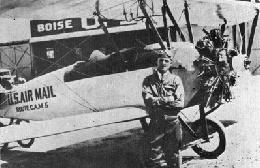On April 6, 1926, Pasco celebrates the first Air Mail Delivery in the Columbia Basin when Varney Airlines Chief Pilot Leon Cuddeback takes off from Pasco Airport bound for Elko, Nevada. On board the plane are 207 pounds of mail, consisting of 9,285 individual pieces. From Elko, the mail will be transferred to planes destined for other American cities, including New York City. An estimated 4,000 to 6,000 people are on hand to celebrate the occasion.
From Stagecoach to Airplane
The event was much anticipated by the Tri-Cities (Richland, Pasco, and Kennewick) and by many other mid-Columbia towns and cities. Sending letters and packages by air would greatly decrease transportation time. Local officials planned an all-day celebration, including speeches, demonstrations, and a parade to show their appreciation for this technological advance. A special program was printed to outline the events of the day.
At 5:30 a.m., on April 6, officials assembled at the post office. A few minutes later, one Felix Warren arrived in an old stagecoach to pick up the mail. The stagecoach had been used 58 years earlier to transport passengers and freight between Colfax and Walla Walla. The old coach still showed bullet holes from past Indian battles. The stage signified the passing of the flame from the old to the new.
Warren drove his six-horse team to the airport, where he delivered the mail to the plane that would carry it. Besides letters, he delivered bottles of grape juice destined for President Coolidge and a box of asparagus destined for Postmaster General Harry New.
Varney Airlines Takes Off
Leon Cuddeback, chief pilot for Varney Airlines, loaded the mail into a single-seat Swallow biplane. The government had awarded the air mail contract to Varney Airlines after it submitted the only bid for the route. Walter T. Varney founded the airline after operating a California flying school and an air-taxi service.
A few minutes after loading on the mail, Cuddeback launched his plane, which was powered by a 150-hp Curtis C6 water-cooled engine with a top speed of 90 miles per hour. He flew for about four hours, landed in Boise, and there refueled and loaded on another 150 pounds of mail. He took off again, endured a violent spring storm, and landed an hour later at Elko.
Planes and Games
Back in Pasco, the celebration continued. Johnny Wall of Spokane won the 18-hole golf tournament. At Gray-McFarland field, teams from Pasco and Kennewick played baseball. Five National Guard planes of the 116th Observation Squadron flew in that day and entertained the crowd.
At 11:00 a.m., the formal part of the celebration began. State Postmaster J. M. Jones erected a granite slab near the hangar to commemorate the beginning of the air mail service. Roses from Portland's International Rose Test Gardens were planted near the granite marker.
About 11:30, a plane arrived from Seattle and delivered a pouch of mail to local Postmaster W. R. Cox. Mayor Ben Hill of Walla Walla gave the welcome address at a pavilion built on Clark Street. Several prominent men, including Frank M. Louden of the Walla Walla Chamber of Commerce, Postmaster C. M. Perkins of Seattle, President J. W. Spangle of the Seattle Chamber of Commerce, W. C. Culbertson of Portland, and Postmaster J. M. Jones of Portland, also gave speeches.
The Apple Queen Reigns
Afterward, marching bands from Milton-Freewater, Oregon; Walla Walla; Prosser; Sunnyside; and White Bluffs entertained the guests. The master of ceremonies presented Queen Pauline and her entourage from the Wenatchee Apple Blossom Festival. County commissioners and postmasters were called to the stage and introduced, one from as far away as Plummer, Idaho.
At the end of the program, a parade of marching bands and floats made its way to the airport to greet the arrival of the first incoming airmail flight, scheduled for 6 p.m. Dr. S. Limpus of Pasco and C. R. Brownville, mayor of Umatilla, led the parade. But the crowd was disappointed. A storm in Nevada prevented the first plane from arriving. Pilots on hand entertained the crowd and gave rides to interested people. Afterward the crowds dispersed, some attending the American Legion dance at 8:30 p.m. Others stayed at the airport, long past dark, hoping to see the plane come in. They later found out that pilot Franklin Rose had been forced to crash-land in the mountains near Elko. It would be more than 24 hours before the return airmail finally reached Pasco.
Working Out the Kinks
The problems suffered by both pilots highlighted the need for more powerful engines for the airplanes. Varney shut down the route for a month while the airline installed new 200-hp Wright Whirlwind J-4-B air-cooled radial engines to replace the outdated World War I surplus engines.
Airmail service resumed on June 1, 1926. Varney earned a reputation for reliable service with a minimum of delays and accidents. At one time the airline delivered more airmail than any other city-to-city route in the country.

